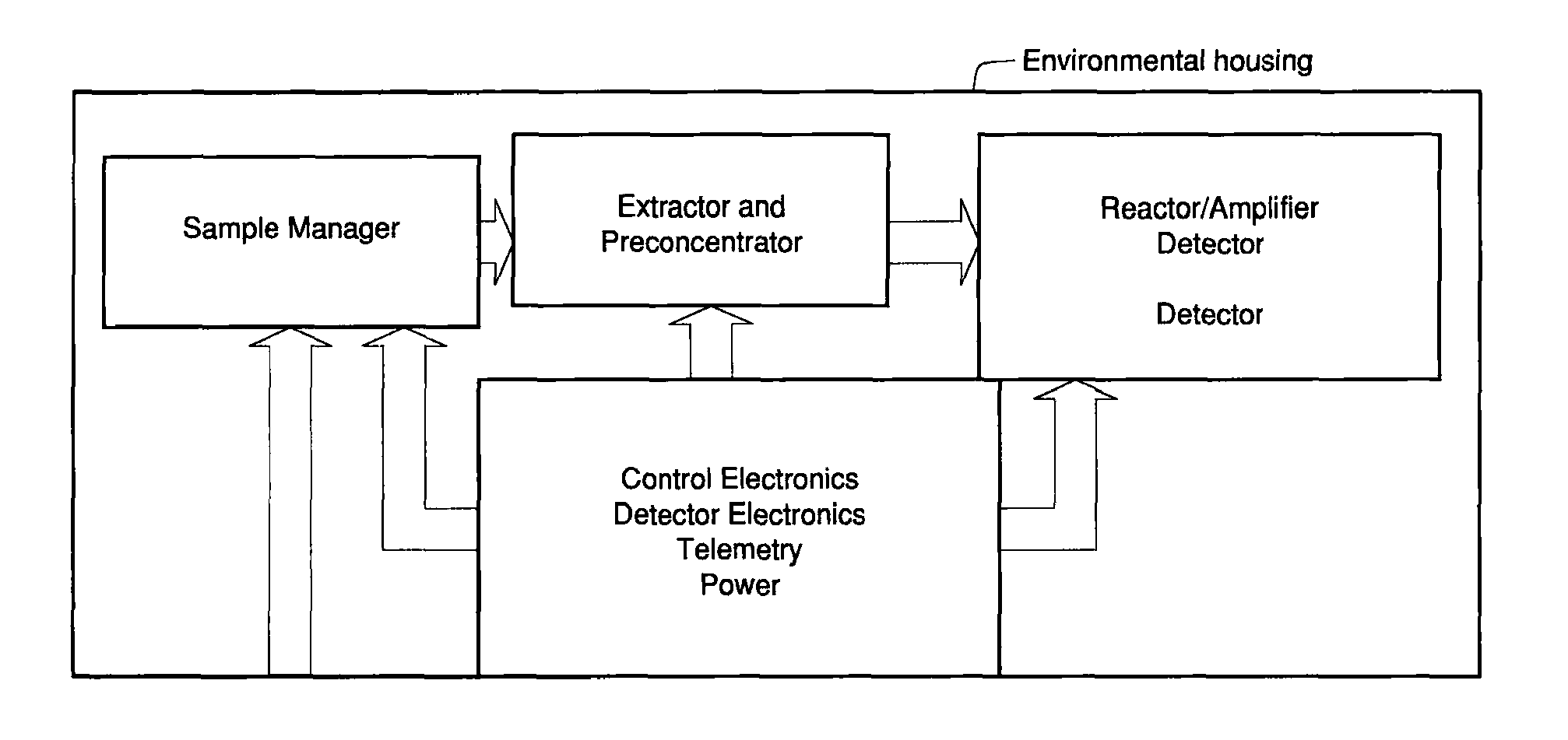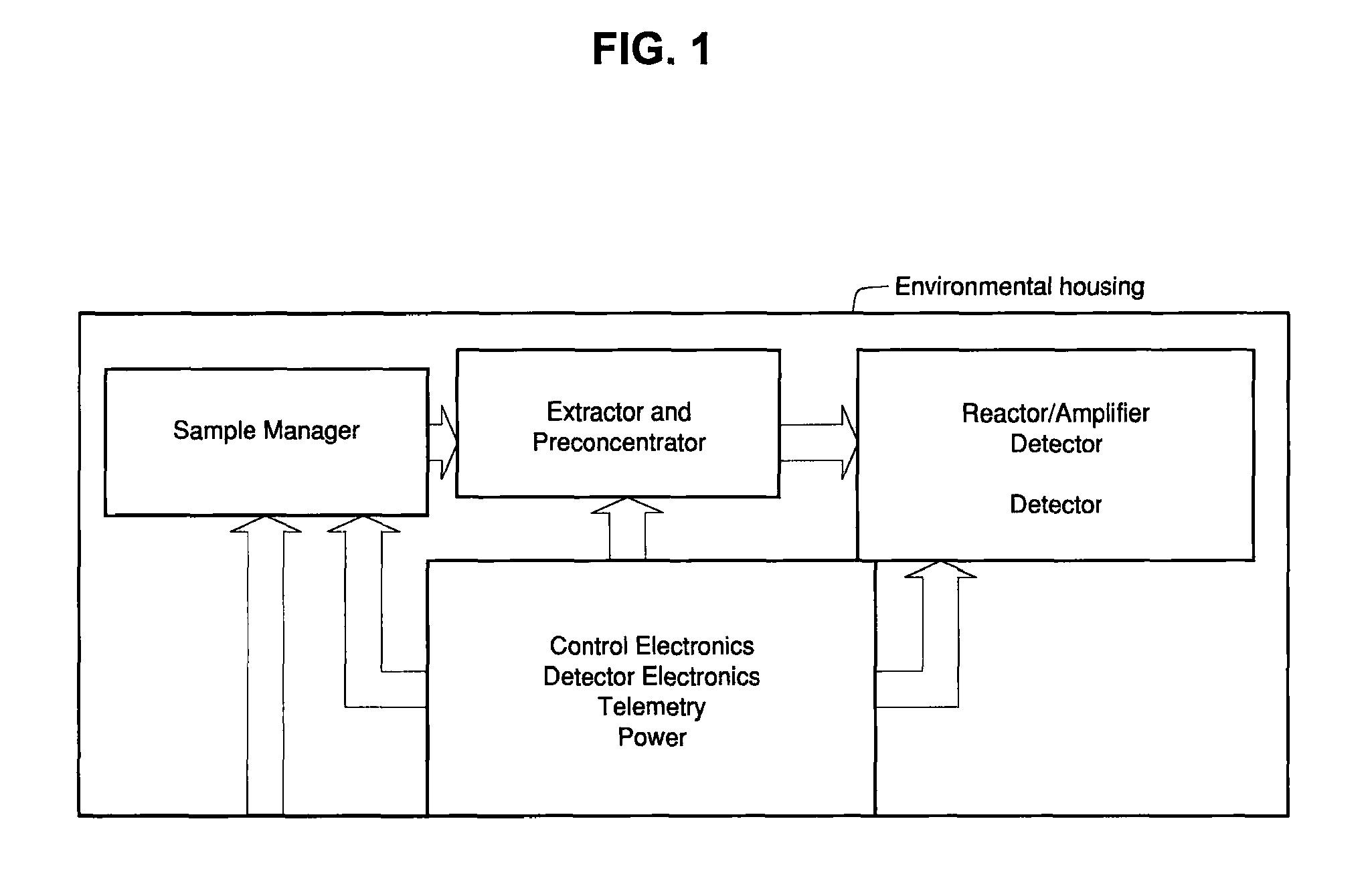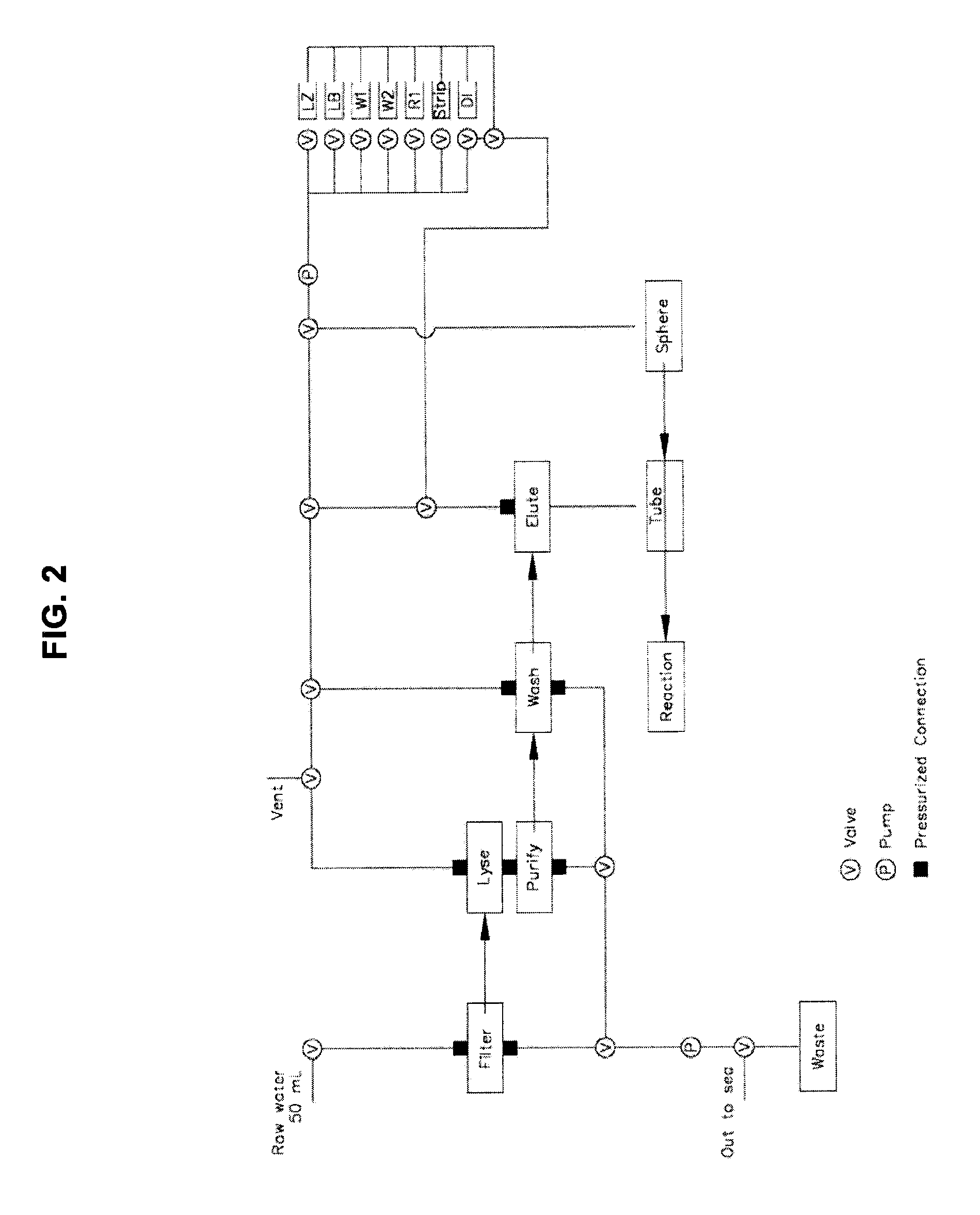Autonomous genosensor apparatus and methods for use
Inactive Publication Date: 2011-04-19
UNIV OF SOUTH FLORIDA
View PDF47 Cites 1 Cited by
- Summary
- Abstract
- Description
- Claims
- Application Information
AI Technical Summary
Benefits of technology
The present invention is a system and method for detecting and identifying microorganisms or molecular biological materials in a marine or aquatic environment or in mixed fluid / solid environments such as boreholes and subsurface sediment. It is a fully functioning system that combines automated sample collection with nucleic acid amplification or other biomarker reactions using molecular probe beacons towards targeted environmental problems. The autonomous genosensor system is open to tuning and reconfiguration for detection of different biological materials through the design and engineering of species-specific recognition probes that are an integral part of the detector subsystem. It can be used in standalone fashion or as distributed networked arrays or payloads on autonomous underwater vehicles, remotely operated vehicles, and other robotic or manned vehicles and watercraft. The autonomous genosensor system includes reactors and detectors suitable for the detection and analysis of physical chemical, biochemical, radioactive, and other biological materials using real-time sample collection, analysis, and data communication aspects. It can also include in situ hybridization analysis and may be provided in the form of an integrated chip, microchip, or MEMS system, or fitted with a fluidic probe stinger. The autonomous genosensor system can be self-powered or powered by any available power supply. The present invention and methods for its use anticipate many alternate embodiments in other potential applications in the broad fields of biology and environmental science and process control.
Problems solved by technology
However, traditional protocols typically require laboratory analysis and a separation between sample collection and analysis.
Method used
the structure of the environmentally friendly knitted fabric provided by the present invention; figure 2 Flow chart of the yarn wrapping machine for environmentally friendly knitted fabrics and storage devices; image 3 Is the parameter map of the yarn covering machine
View moreImage
Smart Image Click on the blue labels to locate them in the text.
Smart ImageViewing Examples
Examples
Experimental program
Comparison scheme
Effect test
examples
[0062]FIGS. 10 and 11A through C contain research data obtained using an embodiment of the present invention to detect and analyze Karenia brevis and Enterovirus in sea water.
the structure of the environmentally friendly knitted fabric provided by the present invention; figure 2 Flow chart of the yarn wrapping machine for environmentally friendly knitted fabrics and storage devices; image 3 Is the parameter map of the yarn covering machine
Login to View More PUM
| Property | Measurement | Unit |
|---|---|---|
| wavelength | aaaaa | aaaaa |
| movement | aaaaa | aaaaa |
| fluorescent resonant energy transfer probe technology | aaaaa | aaaaa |
Login to View More
Abstract
An autonomous genosensor apparatus and methods for use are provided for the field detection and analysis of ambient chemical, biochemical, biologic, biogenetic, and radiologic materials under field conditions in fluid or gaseous environments, such as marine or aquatic environments or industrial processes. Autonomous genosensors provide integral, self contained units which automatically extract environmental samples, prepare those samples for analytical studies, analyze those samples using studies such as DNA or biomarker analysis, and store or transmit the data produced to a remote computer or computer network. Autonomous genosensors may be used as freestanding units, or may be networked and controlled through a remote computer network.
Description
CROSS REFERENCE TO RELATED APPLICATIONS[0001]This application is a Divisional application of U.S. application Ser. No. 11 / 161,103, filed Jul. 22, 2005, now U.S. Pat. No. 7,674,581 which is a continuation of International Application Serial Number PCT / US2004 / 001666, filed Jan. 22, 2004, which claims the benefit of U.S. Provisional Application Ser. No. 60 / 441,876, filed Jan. 22, 2003.GOVERNMENT LICENSE RIGHTS[0002]This invention was made in part under the sponsorship of Grant No. N00014-02-1-0265 awarded by the Office of Naval Research, United States Navy. The U.S. Government has retained rights in this invention.FIELD OF INVENTION[0003]The present invention relates generally to apparati and methods for molecular diagnosis, and relates more specifically to apparati and methods for the field detection and automatic analysis of ambient nucleic acid or other biomarkers in a marine or aquatic environment.BACKGROUND OF THE INVENTION[0004]Molecular diagnostic methods have become a commonpla...
Claims
the structure of the environmentally friendly knitted fabric provided by the present invention; figure 2 Flow chart of the yarn wrapping machine for environmentally friendly knitted fabrics and storage devices; image 3 Is the parameter map of the yarn covering machine
Login to View More Application Information
Patent Timeline
 Login to View More
Login to View More Patent Type & Authority Patents(United States)
IPC IPC(8): C12Q1/68C12P19/34C12M1/00C12M1/36C12N11/16G01NG01N15/06
CPCG01N1/02G01N35/00G01N35/00009G01N35/00069G01N2035/00881
Inventor FRIES, DAVID PPAUL, JOHN HFARMER, ANDREWSMITH, MATTHEW
Owner UNIV OF SOUTH FLORIDA
Features
- R&D
- Intellectual Property
- Life Sciences
- Materials
- Tech Scout
Why Patsnap Eureka
- Unparalleled Data Quality
- Higher Quality Content
- 60% Fewer Hallucinations
Social media
Patsnap Eureka Blog
Learn More Browse by: Latest US Patents, China's latest patents, Technical Efficacy Thesaurus, Application Domain, Technology Topic, Popular Technical Reports.
© 2025 PatSnap. All rights reserved.Legal|Privacy policy|Modern Slavery Act Transparency Statement|Sitemap|About US| Contact US: help@patsnap.com



